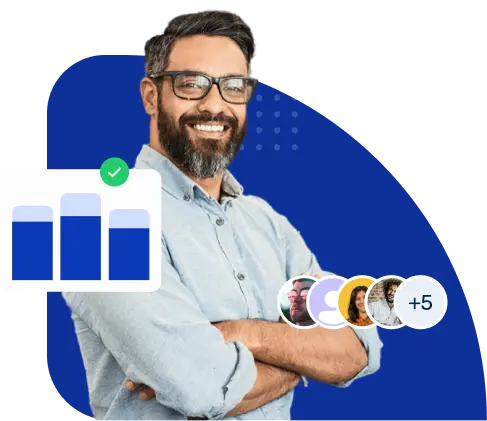With a proven record of creating hundreds of digital products, our certified MVP team helps clients manifest their business objectives with a high-value approach and minimum cost.
Validating business ideas through market research, user interviews, and competitive analysis, ensuring demand before development begins.
Identifying and prioritizing core features to solve primary problems for the target audience and delivering key value.
Crafting interactive, high-fidelity prototypes to refine and advance your product ideas effectively.
Elevate your MVP with enhanced scalability, usability, and market readiness through our development expertise.
100+ skilled professionals delivering robust, scalable MVP applications, turning visions into reputable brands.
Developing operational MVP web and mobile apps to strengthen your online presence and expand customer reach.
Adopting flexible, technology-driven approaches for transparent, high-quality MVP product development and assurance.
Providing technology consulting and insights to save time and costs, with detailed analysis on tech pros and cons.
Offering ongoing support to iterate and evolve products based on user feedback and market demands. Improve performance and add features.
Focus resources effectively and test your market hypothesis with our targeted MVP development approach.

Experience excellence in MVP software development services with PixelCrayons, where quality and innovation converge with efficiency.
Our MVP development company comprises India’s top 1% software talent and consists of expert app consultants, programmers, and designers committed to providing secure, resilient, and cost-effective solutions.
Launch your product swiftly and efficiently with our expert MVP development services.
Regardless of your business size or sector, our software engineering expertise will help grow your operations, automate process, and increase revenue.






Tailoring the Approach to Your Needs

Embrace the culture of collaboration and continuous improvement with DevOps. Our approach integrates development and operations for faster delivery, higher software quality, and more reliable releases, enhancing responsiveness to market changes.

Adopt a flexible and efficient development approach with Agile. Our Agile methodology promotes adaptive planning, evolutionary development, early delivery, and continual improvement, encouraging rapid and flexible response to change.

Implement Scrum for a more structured yet flexible development process. This iterative approach divides development into sprints, focusing on delivering specific features within a set timeframe, fostering teamwork, accountability, and iterative progress.

Choose Waterfall for its sequential, linear approach to software development. Ideal for projects with well-defined requirements and scope, our Waterfall methodology emphasizes meticulous planning, documentation, and stage-wise progression for a structured and disciplined delivery.
We specialize in engineering custom software that's both stable and secure, using a variety of tech tools.
Defining goals and planning for a successful software project.
Creating intuitive design and robust architecture for user engagement.
Building and rigorously testing for reliable, secure software performance.
Launching software smoothly in live environments with minimal downtime.
Delivering software with ongoing support and future enhancements available.
Our MVP product development company in India works on the latest technologies in order to ensure that you get the best solutions for your specific industry needs. We also keep our programmers updated with modern technological trends
With us, you can choose from multiple hiring models that best suit your needs.

Hire an autonomous expert team that, consists of Software Engineers, Quality Analysts, Project Managers and other professionals to deliver efficient and timely technology solutions. Job roles and responsibilities of our experts are discreetly defined for each project, and management is jointly handled by a Scrum Manager and the client’s product owner.

Our team augmentation model allows you to select the right set of talent and experience helping you fill the talent gap in your team. The augmented team works as part of your local or distributed team, attends daily meetings, and directly reports to your managers. This hiring model is suitable for businesses and projects of all sizes.

It is obtained when the project specifications, scope, deliverables, and acceptance criteria are clearly defined, enabling us to evaluate and frame a fixed quote for the project. It best suits the small-mid scale projects having well-documented specifications.
Time & Material Model:It best suits projects with a dynamic scope or complicated business requirements, hindering accurate cost estimation. You pay for the services according to the time spent on the project and get an opportunity to realise the optimum benefits.
Here is our complete guide on MVP Development that you can consider for your next project. This will help you learn about the process, get detailed information, and choose the right team.
![]()
MVP (Minimum Viable Product) development strategy is a product that should only have the features necessary to satisfy customer needs and prove its value. The main objectives of MVP software development services are to quickly validate the product concept, gather user feedback, and iterate based on that feedback. Businesses can reduce the time and money spent upfront by using an MVP strategy and receiving insightful information to help direct future work and guarantee that the finished product satisfies user expectations.
Faster Time-to-Market: MVP development enables businesses to deliver a working product version sooner and get a competitive edge by prioritizing essential functionalities.
Cost Efficiency: With MVP development, businesses can lower development costs and employ resources more effectively by developing the bare minimum functionality required to fulfill consumer needs.
User-Centric Approach: When developing an MVP, businesses can learn from real users and comprehend their preferences, pain areas, and expectations by releasing an early product version.
Risk Mitigation: By adopting an MVP approach, businesses reduce the risks of developing a full-featured product without adequate validation. The iterative nature of MVP development allows for early detection and correction of potential issues or shortcomings.
Increased Flexibility and Adaptability: MVP development enables companies to stay flexible and adjust to shifting customer expectations and market situations.
![]()
MVPs can be broadly divided into two categories: Low-fidelity MVP and High Fidelity MVP.
Low-fidelity MVP: A low-fidelity MVP is a simple method for determining whether there is a market for your idea. For example, a paper sketch that illustrates a function of your mobile app.
High-fidelity MVP: It is more sophisticated and seeks to determine how much customers are prepared to pay for your product. A single-feature MVP, such as an online meal-ordering service, allows you to order food from restaurants.
There are generally four distinct phases in the software development life cycle: requirements gathering, design, implementation, and testing. Depending on the project, there may also be a phase.
Requirements gathering is the first and arguably most important phase of any software development project. In this phase, the team works with stakeholders to understand what they need and want from the software. This includes understanding the business goals, target users, and any specific functionalities that must be included. Requirements gathering can be lengthy, but it is crucial to ensure everyone is on the same page before moving on to the design.
In the design phase, the team starts to map out how the software will work. This includes creating user flows, wireframes, and prototypes. The goal is to create a comprehensive picture of the user experience and how all the different pieces of the software will fit together.
Once the design is complete, it’s time to build the actual software. Developers often use eCommerce automation tools that allow them to quickly and easily create complex ecommerce functionality without writing code from scratch. These tools can save a lot of time and the different pieces of the software fit together. Once again, collaboration is key in this phase to ensure everyone is happy with the project’s direction.
After design comes implementation, the step where the software is built. eCommerce automation helps to speed things up. Developers can create complex ecommerce functionality without having to write code from scratch. These tools can save a lot of time and simplify the development process.
Finally, testing makes sure everything is working as it should. This includes both functional testing (to ensure that the software is doing what it’s supposed to do) and performance testing (to ensure that the software can handle real-world usage scenarios). Once again, ecommerce automation tools can be a big help here, as they can automate many of the tasks associated with testing.
![]()
When building a Minimum Viable Product (MVP) application, focusing on essential features and functionality is important while keeping development costs and time to market in mind. Here are some best practices to consider:
Define the Features: Determine the core functions that address the primary issue your MVP wants to resolve. Put your attention on providing users with value as soon as possible.
Keep it Simple: Reduce complexity by omitting pointless features or design aspects. To promote easy adoption and engagement, prioritize usability and a streamlined user experience.
Rapid Iteration: Adopt an iterative development strategy, continually obtaining user feedback and incorporating updates. Release updates frequently to improve the product based on user preferences and demands.
Scalable Architecture: Use a flexible and modular architecture to design for scalability. This makes it simpler to make upgrades in the future and accommodates the expansion of your user base without requiring an extensive overhaul.
Here are some trends and technologies that are shaping MVP development:
Low-Code/No-Code Development: Low-code and no-code platforms are becoming increasingly common in MVP development. These tools use visual interfaces and pre-built components to enable developers and non-technical people to create applications with little to no code. Faster prototyping and development cycles are made possible by this trend.
Cloud Computing: Cloud computing has transformed how MVPs are created and delivered. Cloud systems provide on-demand resources and services, allowing scalability, flexibility, and cost-effectiveness. They make MVP applications’ deployment, management, and scaling simple.
Mobile-First Approach: Adopting a mobile-first approach has become essential for MVP app development services, given the growing popularity of mobile devices. Key MVP development trends include focusing on mobile responsiveness, building native or hybrid mobile apps, and enhancing the user experience for mobile platforms.
Artificial Intelligence (AI) and Machine Learning (ML): Adding AI and ML capabilities to MVPs has become a prominent trend. The value and functionality of MVPs can be increased by utilizing AI and ML technologies to provide various features like intelligent suggestions, personalized user experiences, data analysis, and automation.
Internet of Things (IoT): The development of MVPs for IoT technologies is gaining traction. New opportunities, including innovative home applications, wearable technology, and industrial automation solutions, are made possible by developing MVPs that connect to and communicate with IoT devices.
Blockchain: The use of blockchain technology in MVP development is on the rise, especially for programs that demand safe and open data transfers. Blockchain technology can improve MVPs’ decentralized functioning, immutability, and data integrity.
When selecting an outsourcing company for MVP development in India, it’s important to consider the following factors to ensure a successful partnership.
Expertise and Experience: Examine the outsourcing firm’s experience and skill in MVP development. Look for a history of successfully completed initiatives, especially in your sector or field. Examine their technical expertise, familiarity with related technologies, and capacity to produce high-caliber software.
Portfolio and References: Review the outsourcing company’s portfolio and references to get an idea of the variety and complexity of their previous projects. Ask for references and testimonials to learn more about their competence, professionalism, and client satisfaction levels.
Team Composition and Skills: Consider the team members of the outsourced firm, such as developers, designers, project managers, and quality assurance specialists. Ensure they have the knowledge and experience to develop your MVP by evaluating their credentials, experience, and skill sets.
Collaboration and Communication: Successful outsourcing relationships require effective collaboration and communication. Consider the outsourcing provider’s channels for communication, responsiveness, and capacity to comprehend and adhere to your project’s requirements. Ensure they offer frequent project updates and are amenable to suggestions and dialogue.
Project Management Approach: Recognise the project management techniques used by the outsourced firm. Check if they adhere to agile approaches like Scrum or Kanban, which encourage adaptability, iterative development, and tight cooperation. Evaluate their capacity to handle change requests, manage risks, and fulfill deadlines.
Testing and Quality Assurance: Ask them about their testing procedures, bug-tracking systems, and dedication to producing an MVP that is trustworthy and error-free. Inquire about their quality control procedures and how they ensure the finished product satisfies your criteria for quality.
Post-Development Support: Discuss the outsourcing firm’s maintenance and post-development support services. When the MVP is released, ask them how quickly they will respond to issue repairs, feature additions, and continuing technical support. Clarify their availability for future revisions and updates and their long-term commitment.
You can learn more about transforming from MVP to a Full-Fledged Product from our blog post.
Gain industry insights and learn from our proven track record with our latest blogs and case studies.
Scaling a software solution from a humble Minimum Viable Product (MVP) to a full-fledged powerhouse product is no easy feat. …
Learn MoreYou developed a mobile app and added all the necessary features you thought your target audience would need. You assumed…
Learn MoreDo you have any queries related to MVP app development services in India? Here are some frequently asked questions about MVP development services that our clients often ask. If you have any other queries, feel free to contact us.
PixelCrayons provides contemporary MVP development services for startups and enterprises looking to develop best-in-class software applications that offer a growth-centric competitive advantage. Our experts handle complex projects and develop safe, scalable, high-performance web solutions to help multiply business revenue and gains.
The cost and time of developing MVP development services for startups and enterprises depend on several factors, such as the size and complexity of the website, APIs, animations, localizations, backend, cross-platform toolsets, and platforms. Let us know your vision, and we will provide you with an ETA and an estimated cost.
The time our MVP software development company takes depends on the project’s complexity, scope, size of the team, and development methodology. Developing an MVP can take a few weeks to a few months. It is crucial to remember that MVPs are made to be produced quickly, concentrating on necessary features to verify the concept effectively.
We have a skilled team of professionals who specialize in building MVPs for various industries and domains. With over 20 years of industry experience, we are a leading MVP software development company in India having delivered numerous MVP projects, making them well-versed in the intricacies of this development approach.
Here are some of the examples of MVP projects our team has worked on:
It is essential to follow best practices and implement appropriate measures. Here are some general steps that can be taken to ensure security and confidentiality:
Secure Development Practices: Use secure coding techniques and adhere to industry-recognized best practices to reduce vulnerabilities during development. This covers procedures like secure authentication, input validation, and defense against widespread security threats like SQL injection and cross-site scripting (XSS).
Data Encryption: Encrypt sensitive data using encryption techniques to safeguard it both in transit and at rest. This involves encrypting stored data with robust encryption techniques and transmitting data over secure protocols like HTTPS.
Access Control and Authentication: Implement strong user authentication mechanisms, such as strong password restrictions, multi-factor authentication (MFA), and role-based access control (RBAC), for access control and authentication. Utilise user roles and permissions to restrict access to the application’s private portions.
Secure Hosting and Infrastructure: Use secure coding techniques and adhere to industry-recognized best practices to reduce vulnerabilities during development. This covers procedures like secure authentication, input validation, and defense against widespread security threats like SQL injection and cross-site scripting (XSS).
Secure Third-Party Integrations: Encrypt sensitive data using encryption techniques to safeguard it both in transit and at rest. This involves encrypting stored data with robust encryption techniques and transmitting data over secure protocols like HTTPS.

Stay ahead with MVPs built using cutting-edge technology, designed for scalability and market leadership.
Let us show you how our digital services can drive your success.